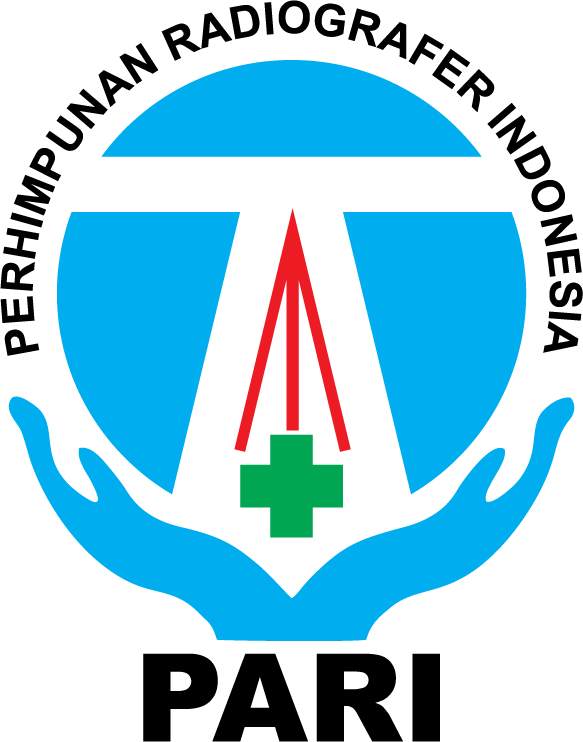Teknik Pemeriksaan Kedokteran Nuklir Bone Scan di Instalasi Radiologi RSUP Dr. Kariadi Semarang
Abstract
Background: A bone scan or commonly referred to as bone print is nuclear medicine examination using a radioactive substance or radiopharmaceutical that is inserted into the body through intravenous injection which aims to help diagnose abnormalities that occur in the bone. This imaging procedure uses a radiopharmaceutical 99mTc-MDP (methylenediphosphonate) is the most commonly used radiopharmaceutical.
Methods: The patient will be injected with this radiopharmaceutical at a dose of 15-20 mCi, through the vein in the hand. Imaging can be done as soon as the radiopharmaceutical is injected or after a while to wait for the radiopharmaceutical to be distributed and absorbed by the bone, about 3-5 hours later. Imaging is done by three-phase method, namely the first phase (Vascular phase), the second phase (Blood Pool phase), and the third phase (Total body phase) l.
Results: The bone scan method is an efficient examination because in 1x the imaging can provide a complete picture from the head to the foot. Evaluation of results, under normal conditions the distribution of radioactivity in the bone appears symmetrical.
Conclusion: In the process of bone metastasis, it can be seen that typical pathological radioactivity can be multiple (multiple hot spots). Malignant tumors can be distinguished from benign tumors by blood pool examination.
Keywords
Full Text:
PDFReferences
Cheran, S. K., Herndon, J. E., & Patz, E. F. (2004). Comparison of Whole-body FDG-PET to Bone Scan for Detection of Bone Metastases in Patients with a New Diagnosis of Lung Cancer. Lung Cancer, 44(3), 317–325. https://doi.org/10.1016/j.lungcan.2003.11.008
D, D. C. (2011). Bone Scan Medice Plus.
GE Medical Health. (2005a). Manual Book of Infinia.
GE Medical Health. (2005b). Xeleris Processing.
Jana, S., & Blaufox, M. D. (2006). Nuclear Medicine Studies of the Prostate, Testes, and Bladder. Seminars in Nuclear Medicine, 36(1), 51–72. https://doi.org/10.1053/j.semnuclmed.2005.09.001
Masjhur, J. S., & Hussein, A. S. K. (1999). Buku Panduan Tata Laksana Diagnostik dan Terapi Kedokteran Nuklir. Terapi Kedokteran Nuklir.
Shie, P., Cardarelli, R., Brandon, D., Erdman, W., & AbdulRahim, N. (2008). Meta-analysis: Comparison of F-18 Fluorodeoxyglucose-Positron Emission Tomography and Bone Scintigraphy in the Detection of Bone Metastases in Patients With Breast Cancer. Clinical Nuclear Medicine, 33(2), 97–101. https://doi.org/10.1097/RLU.0b013e31815f23b7
Van den Wyngaert, T., Strobel, K., Kampen, W. U., Kuwert, T., van der Bruggen, W., Mohan, H. K., Gnanasegaran, G., Delgado-Bolton, R., Weber, W. A., Beheshti, M., Langsteger, W., Giammarile, F., Mottaghy, F. M., & Paycha, F. (2016). The EANM practice guidelines for bone scintigraphy. European Journal of Nuclear Medicine and Molecular Imaging, 43(9), 1723–1738. https://doi.org/10.1007/s00259-016-3415-4
Weiner, R. E. (2006). The Scientic Basic of Nuclear Medicine, Bone Imaging Radiopharmaceuticals, Technetium 99m Diphosphonates,
Biologic Behavior (2nd ed.). Mosby Elsevier.
Yudistiro, R. (2012). Kedokteran Nuklir : Apa dan Bagaimana?
DOI: https://doi.org/10.31983/jimed.v7i1.6657
Article Metrics
Refbacks
- There are currently no refbacks.
JURNAL IMEJING DIAGNOSTIK by http://ejournal.poltekkes-smg.ac.id/ojs/index.php/jimed is licensed under a Creative Commons Attribution-ShareAlike 4.0 International License.

.png)
.png)
.png)
.png)
.png)
.png)
.png)











